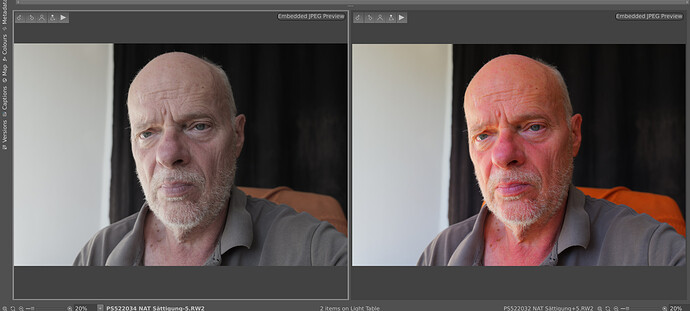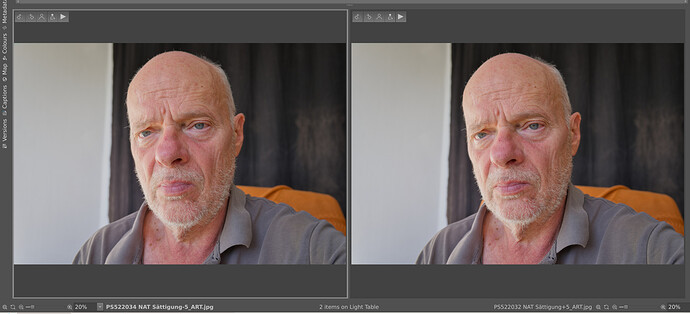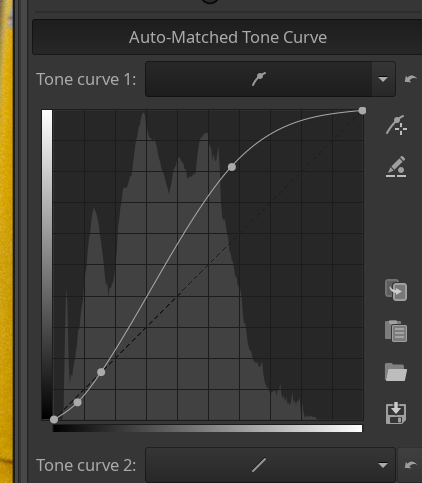I have just made an interesting observation:
The photostyle selected when taking the picture does have an influence on the raw development - it changes the curve when Auto-Matched Tone Curve is selected.
NAT makes softer images than STD, and FLAT even softer and less saturated. However, the settings in the Photostyles have no influence on the RAW development. The saturation and hue remain unchanged. This is the case with my Panasonic Lumix. Both with the profiles: Camera standard as well as Auto-matched camera profiles in ART. Is this normal?
I’m not sure what you mean exactly. What the auto-matched curve does is compare the embedded jpg to the raw image, and apply a tone curve to try and match the tone contrast of the raw image to that of the embedded image. It does only modify the tone curve, and does not match saturation per se, but of course saturation will change depending on the tone curve applied.
isnt the whole point of the automatch curve that it tries to mimick the look of the OOC jpeg?
you can always skip that step if you do not want it for a picture.
My aim is to gain a better understanding of the underlying processes so that I can apply them more effectively.
I was very surprised to see that the “Camera standard” profile on my Panasonic S5M2 delivers better results than “PANASONIC DC-S5M2.dcp” because it has less red cast.
Now I wanted to know why that was. I thought maybe it was because I had selected NAT as the photostyle when taking the picture and had shifted the hue toward green.
Tests have shown that the camera’s photostyle only affects the tone curve, but the saturation and hue have no influence on “Camera standard” when developing in ART.
I just wanted to use this topic to make sure that this is normal.
I would like to know which parameters in the camera settings have an influence on RAW development—and which do not.
Basic exposure settings (shutter speed, aperture, ISO, white balance) will show a difference in ART. But any picture style (or photostyle) will only affect the jpegs (including the jpeg embedded in the raw file) and should not affect the raw data. It is because it affects the embedded jpeg that you can see a difference with the auto-matched tone curve because, as I said earlier, ART uses the embedded jpeg to estimate the the tone curve.
The DCP file is something else entirely, it is used by ART to converter data from camera space to linear RGB (see The processing pipeline in ART | ART raw image processor).
… this part is unclear to me… Saturation and Hue from what? The Camera standard is the input profile used early in the ART pipeline, it can not be influenced by anything, but it does influence color and tone rendering later on.
Panasonic has this photostyles. These generate different tone curves, which result in different contrasts with Auto-Matched Tone Curve.
- [Standard] - standard Panasonic color profile
- [Vivid] - Brilliant effect with high saturation and contrast
- [Natural] - Soft effect with low contrast
- [Flat] - A setting that produces a flatter image quality with lower saturation and contrast.
- [Monochrome] -black and white effect
- [Scenery] - effect of amplifying blues and greens, suitable for landscapes
- [Portrait] - effect suitable for portraits enhancing healthy and beautiful skin tone
- [Cinelike D] - effect designed to prioritise dynamic range by using a gamma curve suitable for film-like images – highly recommended for editing
- [Cinelike V] – film like, with increased saturation
And then there are these subcategories, which have no effect on ART:
- Contrast ratio
- Highlights curve
- Shadows curve
- Saturation
- Hue
- Sharpness
- Noise Reduction
Does that mean that ART only adopts the tone curve from the embedded JPEG and not the other settings?
Are you sure that you can cumulate/add these settings to the photo style, and that photo style doesn’t override the filter setting, and vice versa?
Yes, absolutely sure. They are subcategories of the photo style, and you can clearly see that they have an effect in the JPEG of the RAW file.
The RAW files with photostyle NAT: left saturation -5, on the right +5
Here the images developed with ART: saturation -5 on the left and +5 on the right.
Its (ATM) just analysing the jpg histogram and then trying to calculate a tone curve that will match that tonal profile in the raw processing…color can sometimes be impacted depending on the curve but its not intrinsically doing anything with color as far as I understand it…
Infact if you use an adobe profile with its tone curve and leave the ATM on, often it is a strait line or very minimal curve as the default adobe curve is similar to what would cover the calculation… but leaving the tone curve module on still lets you impact your edit with all the other settings as well and this is where you get into those models and profiles
I think this is why many people that want to edit with a consistent workflow will work to a neutral starting point and then grade images rather than use something that can introduce variable starting points…
If you are going to consistently use the ATM then I would shoot with the profile that gives your images the tonal profile that you like as that will be transferred to the raw when using ATM actively applied…
But as I said earlier, the auto-matched tone curve in ART estimates the tone contrast of the embedded image, it does not estimate color saturation.
Now, try one photo style alone and and then photo style + contrast ratio. Since contrast ratio should also affect the tonal contrast in the embedded jpeg, ART should apply a different auto-matched tone curve.
I just tried it out: The “Contrast ratio” in the camera’s photostyle affects the tone curve of Auto-Matched Tone Curve accordingly. The same applies to the “HIghlights curves” setting.
My workflow: In the camera: Photostyle NAT and in ART: “Auto-matched camera profile”, which gives me a very good starting point.
It seems very tedious to me to always have to draw such a beautifully shaped curve with the mouse if I had to work without this A-MTC.
Then maybe I totally missed what you are trying to do.
Another thing you can try is to disable auto matched curve, use the contrast slider above and it to the s-curve mode. If you don’t like how it behaves in the mid tones you can the add 1 point to the tone curve and adjust the mid tones from there.
Or, I tou still want auto matched curve as a starting point, you can enable the Tone curve 2 below it and adjust tone with 1 single point.
Hello @sguyader
I probably expressed myself too complicatedly.
I have no problems with ART – everything works well and is very logical. I really like using A-MTC. It’s no problem to adjust the contrast perfectly afterwards, especially with “Log Tone Mapping.”
My challenge is the colors of the Panasonic camera: sometimes excellent, sometimes too reddish for faces.
When taking a photo, you can adjust a number of settings that affect the color, such as hue and saturation. However, these have no influence on RAW development.
And that was the question of this topic: Which settings have an influence, which do not.
As I see it now, white balance has an influence, but only when I select “As shot” in ART, that much is clear. And the factors that affect contrast influence the tone curves (photostyle itself, contrast ratio, highlights curve, and shadows curve) when I select A-MTC.
All other settings in photostyle have no effect whatsoever – good to know.
You should switch to a Fujifilm camera for world-class color science ![]()
The Jpeg OOC from Fujifilm are famous. I assume that you use Fuji cameras. Are the colors of the RAF from Fuji also better than those from other manufacturers?
I once had a Fuji that was good, but I was only at the beginning of my RAW photo experience. But the X-Trans was not always so pleasant. I switched to Panasonic years ago because Fuji wasn’t quite ready for video.
It was more of a joke. That said, I have no issues with strange color shifts with my Fuji raws.


